By Lucia Gates
All photos courtesy of Wikimedia Commons
Like gardeners everywhere, we Belmontians struggle with weeds. While it might be tempting to take the easy approach and eliminate them with herbicides and chemical weed killers, as gardeners we also know that we have to protect everything in our garden. There are ways to manage weeds safely.
This article focuses on flower beds and not lawns, although some of the information will be useful in grassy situations. Also, some weeds, such as wild grape vines and wild multiflora roses, are unlikely to be a problem in a flower bed, but they do love empty spaces, such as behind sheds and garages, over fences, and in empty corners—all the areas we put off working on, thus leaving time for the weeds to move in.
Of the hundreds of weeds in New England, 10 account for our biggest headaches. Some are dangerous, like poison ivy; some a nuisance to our neighbors, like Japanese knotweed; some are aggressive with other plants, like bittersweet; and some are fast spreaders who just don’t know their place, like garlic weed. All are plants in the wrong place, and that, by definition, is a weed.
First, a word about composting. Never throw “weed seeds” into your compost pile as the seeds can survive long periods of heat and drought. The bright orange seeds of bittersweet should especially be avoided. Be very careful to keep poison ivy leaves, stems, and roots out of your compost pile, lest you produce toxic soil.
Second, a word about tools. Mostly your own hands are the right tools for pulling up small seedlings. But for deeper rooted weeds such as dandelions or wild garlic, a special tool is needed. Any good garden center will carry “weeders”—a long-bore tool with a forked end. You push the tool deep into the ground next to the weed and pull it up with a slight sidewise tilt.
The Nasty Ones
Poison Ivy, Toxicodendron radicans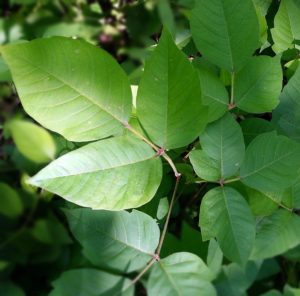
This common but toxic plant is a major cause of contact dermatitis. Because so many people are allergic to it, it should always be treated with care and removed whenever possible. Even though the plant form varies from ground cover to bush to vine, it is easily recognizable, with three roughly oval pointed leaves. All parts of the plant contain urushiols—the compounds that cause reactions in humans. Because these urushiols can remain potent for up to a year on dead plants, the stems and dead leaves need to be avoided even in winter.
Young plants can be pulled by hand, if the hand is protected. An easy way is to put a large plastic trash bag over your entire hand and arm. Pull up the plant, then turn the bag inside out so that the plant is inside the bag. Throw it all out and do not compost it. Even in well-tended gardens, poison ivy can hide in bushes and become quite invasive. If it vines up a tree or throughout a bush, it is best to call professionals.
Poison ivy is an exception where herbicides might be necessary. If you pull out a plant and it keeps coming back from well-established roots, you may need to consider a weed killer. But use it judiciously. First, remove as much of the plant as possible and dab the weed killer directly onto short stems so that it is absorbed down into the roots.
Japanese Knotweed, Polygonum cuspidatum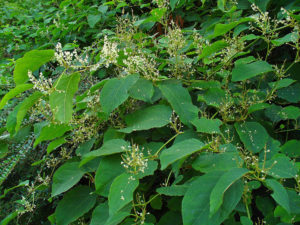
This is an attractive, ornamental plant introduced from Japan by landscapers for its easy cultivation in difficult spots. It can be seen along roadways, such as western Concord Avenue, and behind the main library in Belmont. However, knotweed has become a menace due to its aggressive, fast-moving rhizomes, which can spread 20 feet and pierce through hard-packed soil and asphalt. This is a very difficult plant to control. In small situations such as the average Belmont yard, it can be hand-pulled, but this takes constant vigilance over a large area (remember those 20-foot roots).
In this case, all foliage and stems have to be removed, leaving eight-inch stems. Herbicides are then dabbed on the cut end of the stem so that the plant will pull the herbicide down into the root system, keeping it from the surrounding soil. But it also takes vigilance, as the roots will continue to push out new sprouts for years.
Bittersweet, Celastrus orbiculatus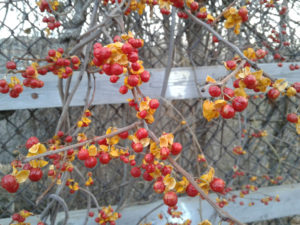
The bright yellow and red seeds of bittersweet are beautiful in the fall, but the plant is a fast-growing vine that can strangle even the largest of trees by twisting up and around the branches. Many people use the cut vines to form wreaths for front doors. But every falling seed leads to more vines, so it is best left in nature.
Young bittersweet plants have pale green leaves and can easily be identified by their neon orange roots. Older plants can be identified by their twisting, woody vines, creeping up through trees seeking the sun.
Pulling young plants out is easily done, and the more you pull, the easier it gets to recognize the leaves. Older plants are tougher to deal with. First, cut the trunk of the vine off at the base—do this before seeds are formed in the fall. Be very careful pulling the dead vines down; because of their twining growth habit, they attach themselves cunningly to bushes and trees. Rough pulling can lead to breakage in the tree you are trying to protect. Best to let the stems and leaves die off naturally. Using a garden fork, dig up bittersweet roots as deeply as you are able to. And then for years watch out for new plants in the area around the dead vine.
Black Swallowwort, Cynanchum nigrum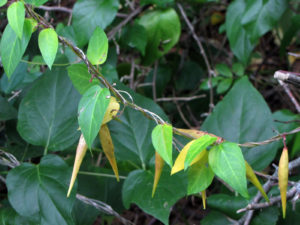
This is the really nasty one, so common in our area that it has been called the official weed of Belmont. The stems, smooth and unbranched, twist up through plants, fences, and bushes. The leaves are dark green, roughly ovate, and simple. Until you get used to the plant’s look, the fastest way to identify the plant is by the long, slender seed pods which look like green beans or milkweed pods. Unfortunately, by the time seed pods are produced in mid-summer, you have already lost the game and new plants will grow from the seeds.
So, what do you do? Pull, pull, and pull some more. Throw the weeds into the trash (not compost) and keep pulling. If you have the misfortune to find a well-established patch, you can try digging up the roots. And you will still have to pull the new shoots. But given time, diligence, and elbow grease, black swallowwort can be conquered.
The Vines
Virginia Creeper, Parthenocissus quinquefolia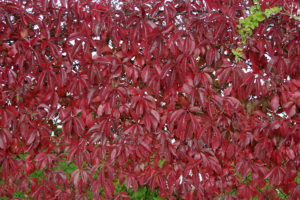
Virginia creeper looks similar to grape vine, but has compound leaves, whereas grape leaves are single. It “creeps” in part by forming adhesive disks that allow it to grow up and over brick walls. It can damage homes when it gets into window frames or chokes out gutters and eaves. While the look of an ivy-covered wall is iconic in New England, it needs to be kept under control. If the vine is growing up a wall, you will need a ladder to reach up and pull off dead vines. Like other vines, it can be controlled by cutting off the base. Virginia creeper spreads quickly by lateral vines. These vines can creep through a yard growing low enough to escape even mower blades and must be pulled out by hand.
Wild Grape Vines, Vitis spp.
Easily identified by their grape leaves and woody vines, wild grape vines can be quite charming along an old stone wall or wooden fence and are native to New England. But they can be a problem when they creep into bushes or up trees, where they can block light from tree leaves. As with bittersweet, they are easily pulled when young. Once the woody vine has formed, it can be cut off at its base. And like bittersweet, you have to be careful pulling the vine off of your desirable plant. Given time, the vine will die off if you have clipped the vine at its base.
Multiflora Roses, Rosa multiflora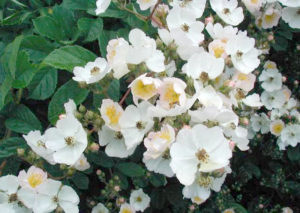
Multiflora roses were introduced from East Asia to be used as rootstock for more desirable roses, but they quickly escaped cultivation. This rose has white flowers, red fruits that last into winter, and fringed stipules (appendages) on leaf petioles. Beware this beauty, as it is a threat to your other plants. It spreads by both seeds and runners and forms long arching stems that combine into thickets to drive out other plants. The only plants likely to survive such a thicket are the other wild vines. A thicket of rose, bittersweet, and grape vines is a nasty prospect indeed.
The Innocuous But Difficult
Wild Onion, Allium stellatum, or
Wild Garlic, Allium vineale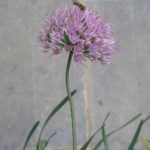
These plants are easy to spot, as they look like chives and smell of onion or garlic. They are not aggressive to other plants and even have a bright, natural look in the spring. But as they spread, they can give a weedy look to a well-tended garden. Use the “weeder” tool to weed these plants out, as you need to remove the underground bulb. Be aware that the bulb can last for many years and can propagate even five years later.
Garlic Mustard, Alliaria officinalis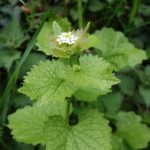
This simple plant with heart shaped leaves and small white flowers is a true member of the mustard family and is not related to wild garlic. But it does have a strong garlic smell, hence its name. This plant is native to Canada, but over the last 20 years, it has become a problem in Boston suburbs. While not aggressive in its plant growth, its numerous seeds can spread throughout a neighborhood in only a few seasons. It needs to be pulled out and thrown away, hopefully before it forms seed heads.
Buttercups, Ranunculus repens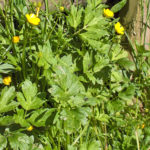
All buttercups are charming in the spring but become problems as they spread. Ranunculus repens’s long creepers are particularly hard to control. As you weed, feel along the spider-like runners for the central nodes and pull them out. By dint of careful pulling, these weeds can be controlled. An interesting note about buttercups is that they like damp soil and so indicate spots in your garden where you have too much water. A dense buttercup crop can even indicate a leaking water system.
Weeds If You So Choose
There are many wildflowers that elicit mixed opinions. To some they are delightful spring flowers; to others they are an annual spring chore to be weeded out. Violets—and the entire Viola family—top the list, and can easily be pulled out if you wish. This is also true for celadine, Chelidonium majus, with its bright yellow flowers. Dandelions, Taraxacum officinale, have a certain charm, but one seed head can spread the plant everywhere.
Milkweeds, Asclepias syriaca, are the only plants on which monarch butterflies will lay eggs. So although they are commonly classed as weeds in the garden, cultivating them is encouraged.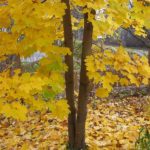
Norway maples are large, magnificent trees providing welcome shade but as seedlings are also a menace in the garden. Anyone who has a nearby Norway knows that they can produce thousands of tiny seedlings. They need to be pulled out early, as the larger the seedling gets, the stronger it grows. Also, watch your bushes and hedges carefully, as Norway maples tend to grow unnoticed up through hedges.
One Last Problem Plant
Common buckthorn, Rhamnus carthatica, forms a large woody bush that can grow to the size of a small tree. Like many invasive plants, buckthorn was originally introduced for landscaping uses. It is amazingly durable and can withstand a variety of climate conditions. It might be desirable, if only it didn’t spread so vigorously. The only solution is to cut down the bush and dispose of it. Then, over many seasons, watch for new shoots and saplings—cut these down as quickly as possible. Be vigilant!
Now that your gardens are weed-free, there’s room for the desirable plants. In Belmont we see lots of daffodils, day lilies, roses, and phlox in the sunny spots. In the shady spots—and we have a great deal of shade thanks to our wonderful trees—Belmont gardeners plant ferns and hostas. Without weeds to choke out your favorite plants, there is a world of beauty to cultivate in your garden.
Lucia Gates is chair of the Belmont Shade Tree Committee and a member of the Belmont Garden Club.
REFERENCES
Niering, W., Olmstead, N., The Audubon Society Field Guide to North American Wildflowers, Eastern Region, Alfred A. Knopf, Inc., 1979.
Peterson, R., McKenny, M., Peterson Field Guides; Wildflowers, Northeastern/Northcentral North America, Houghton Mifflin Company, 1968.
Stokes, Donald, Stokes, Lillian, Stokes Nature Guides; A Guide to Enjoying Wildflowers, Little Brown and Company, 1984.
Uva, R., Neal, J., DiTomaso, J., Weeds of the Northeast, Cornell University Press, 1997.
A Weed By Any Other Name
Many weeds have multiple common names. For example, garlic mustard is commonly called garlic weed, yet these are two very different plants. Weeds are notorious for adapting to different environments and even imitating other plants around them. Use botanical names to avoid confusion.


Sorry, the comment form is closed at this time.